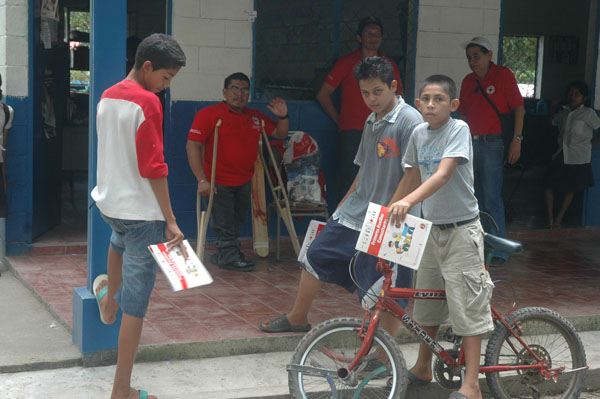Regional project: “Increased impact: Harmonizing materials, methods and tools for community-based and institutional disaster management”

Photo: © IFRC
Carried out by the International Federation of Red Cross and Red Crescent Societies (IFRC), with financial support from the European Commission’s Humanitarian Aid Office (ECHO), and in the context of DIPECHO V, this project is intended to reduce disaster risk through better preparedness of vulnerable population in disaster-prone areas throughout Central America.
This is being done by strengthening the operational capacity and improving cooperation among Red Cross organizations and their partners, as a result of exchanging and applying experiences and best practices.
A number of tools and approaches in the field of disaster preparedness, at both institutional and community-based levels, have been harmonized, tested and validated, accompanied by a standard training program to ensure that the staff and volunteers of these organizations have the knowledge and skills required. The project also included transferring knowledge and experiences from both participating communities and institutions.
These actions have been made possible through the creation and efforts of two regional reference centers, which have been in service for some years now in Costa Rica and El Salvador. Both centers receive technical and financial support from the IFRC´s Regional Representation Office for Central America and Mexico.
1. The Regional Reference Center for Community-Based Education on Disaster Reduction (CRRED)
The Regional Reference Center for Community-Based Education on Disaster Reduction is a tool used by the IFRC to help build disaster risk reduction and preparedness capacities at the local level, by advancing the development of approaches, tools and harmonization processes, and by applying best practices and technical knowledge developed by different Red Cross chapters in the region.
All materials have been developed by applying a participatory education approach, which incorporates three key elements:
1. Practice as the starting point, since it includes the knowledge and experiences gained by people.
2. Theorization, which refers to building knowledge collectively.
3. Revisiting practice. This step refers to putting into practice the knowledge attained along the process.
|
To this end, the series titled “Better be Prepared” has been developed and includes 14 modules of community-based education in the field of disaster risk reduction. The modules are:
1. Community-based education, organization and preparedness for risk reduction.
2. Prepared families.
3. Community first aid.
4. Protected schools
5. Temporary shelter management
6. Psychological first aid
7. Healthy homes
8. Community-based school maintenance
9. Floods
10. Disaster prevention in rural water lines
11. Early warning systems in minor watersheds
12. Community-based dialogue on water and climate
13. Social micro-projects
14. Community-based teams for disaster risk reduction.
2. The Regional Reference Center for Disaster Preparedness (CREPD)
The Regional Reference Center for Disaster Preparedness is used by the IFRC to help build disaster preparedness and response capacities at the national level, and reduce existing vulnerabilities.
This is achieved by advancing the development of approaches, tools and harmonization processes, and by applying best practices and technical knowledge developed by different Red Cross chapters in the region.
The following are some of the training courses offered by the Center:
1. Basic Course for National Intervention Teams (NIT)
2. Emergency Operations Management and Control
3. Course for Planning Drills and Simulations
4. Course for Developing Response and Contingency Plans.
At the institutional level, some of the modules developed by the Regional Reference Center for Disaster Preparedness include:
1. Operations safety
2. Development of response and contingency plans
3. Planning of drills and simulations
4. Emergency operations management
5. Emergency assessment
6. Training material for National Intervention Teams (NIT).
Both reference centers also have internships available and promote the exchange of experiences among technical staff and volunteers from many different countries in the region. These centers devote efforts to producing training material for disaster risk reduction and preparedness, and develop a number of training courses.
For further information about the Regional Reference please visit: http://www.cruzroja.org/desastres/redcamp/cenref.htm
|